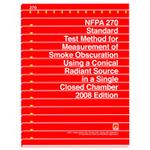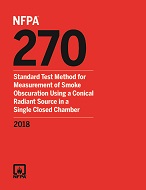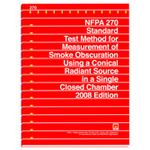
NFPA (Fire) 270
Product Details
- Published:
- 11/29/2022
- ISBN(s):
- 9781455929818
- ANSI:
- ANSI Approved
- Number of Pages:
- 38
- Note:
- This product is unavailable in Ukraine, Russia, Belarus


Click here to purchase
View contents.
NFPA 270: Standard Test Method for Measurement of Smoke Obscuration Using a Conical Radiant Source in a Single Closed Chamber provides fire test labs with a means of measuring smoke obscuration of essentially flat materials, products, or assemblies (including surface finishes) up to 25mm thick, when exposed to specified levels of thermal irradiance in a single closed chamber. This test method is based on ISO 5659-2, Determination of Specific Optical Density by a Single-Chamber Test, and provides equivalent results to ISO 5659-2.
The principal fire-test-response characteristic obtained from using NFPA 270 is the specific optical density of smoke from the specimens tested. An optional fire-test-response characteristic measurable with this method is the mass optical density, which is the specific optical density of smoke divided by the mass lost by the specimens during the test.
The 2008 edition deleted secondary definitions of “ignition”, “smoke obscuration”, and “specimen”.

Click here to purchase
Essential for fire test labs and manufacturers, up-to-date testing criteria in new NFPA 270 helps users evaluate the extent of smoke obscuration.
NFPA 270: Standard Test Method for Measurement of Smoke Obscuration Using a Conical Radiant Source in a Single Closed Chamber provides a means of measuring smoke obscuration of essentially flat materials, products, or assemblies (including surface finishes) up to 25mm thick, when exposed to specified levels of thermal irradiance in a single closed chamber. This test method is based on ISO 5659-2, Determination of Specific Optical Density by a Single-Chamber Test, and provides equivalent results to ISO 5659-2.
The principal fire-test-response characteristic obtained from using NFPA 270 is the specific optical density of smoke from the specimens tested.
An optional fire-test-response characteristic measurable with this method is the mass optical density, which is the specific optical density of smoke divided by the mass lost by the specimens during the test.
The 2018 edition updates the pressure sensor requirements to reflect modern technology.
Other changes included references to other codes and standards.

Click here to purchase
Evaluate the extent of smoke obscuration with the up-to-date testing criteria in the 2013 NFPA 270.
NFPA 270: Standard Test Method for Measurement of Smoke Obscuration Using a Conical Radiant Source in a Single Closed Chamber provides fire test labs and manufacturers with a means of measuring smoke obscuration of essentially flat materials, products, or assemblies (including surface finishes) up to 25mm thick, when exposed to specified levels of thermal irradiance in a single closed chamber. This test method is based on ISO 5659-2, Determination of Specific Optical Density by a Single-Chamber Test, and provides equivalent results to ISO 5659-2.
The principal fire-test-response characteristic obtained from using NFPA 270 is the specific optical density of smoke from the specimens tested. An optional fire-test-response characteristic measurable with this method is the mass optical density, which is the specific optical density of smoke divided by the mass lost by the specimens during the test.
The 2013 NFPA 270 includes updated code and standard references as well as editorial revisions that improve usability and consistency with other standards.